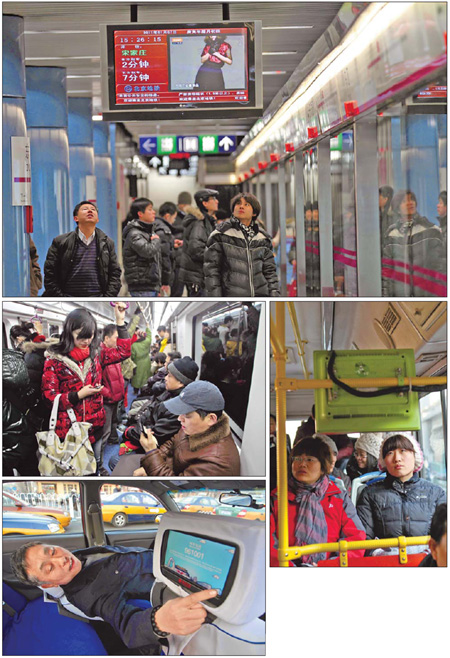Focus
Ad marketing moves with the times
By Jiang Xueqing (China Daily)
Updated: 2011-01-11 07:57
 |
Large Medium Small |
|
|
Major brands invest in mobile TV to tap China's huge commuter market. Jiang Xueqing in Beijing reports.
Zhang Siyang is rarely without his iPhone. He uses it in the mornings to check the weather forecast and read the news headlines. He uses its GPS function for work. And when he's bored, he uses it to listen to downloaded music or read a book.
"It makes my life more convenient," said the 28-year-old Beijing photo editor. "Now I can do lots of things while I'm out and about."
Public servant Chen Jing also gets her information on the move. During her daily 45-minute commute to work, she not only uses her cell phone for updates but also the small television screens now in most train carriages.
The number of people now accessing mobile media on a daily basis in China has soared since 2007, according to CTR, a key market research firm in China.
The shift has already boosted advertising revenues for companies targeting commuters, and the best is yet to come.
"Within the next three to five years, existing channels for Chinese consumers to receive brand and product information will have revolutionary changes," said CTR vice-president Tian Tao. "New media, including mobile media, will be mainstream."
The evolution of mobile media has been helped greatly by changes in the lifestyles and habits of the Chinese audience.
People today spend more time traveling from A to B and have shorter time periods in which to digest information, explained Liu Huizhao, general manager of media strategy at CTR. They are also online 24-hours a day.
However, the biggest lift has arguably come from China's rapid rate of urbanization, which hit a high of 46.6 percent by 2009, according to a report by the Chinese Academy of Social Sciences (CASS).
More than 20 million people became urban residents every year between 1996 and 2005, before dropping off to about 15 million between 2006 and 2009. CASS figures show China's urban population is now double the size of the entire United States population.
The influx has put huge pressure on the cities' public transport networks, which has increased congestion and led to commuters spending more time traveling.
To cope with demand in recent years, the central government invested heavily. In 2009, people made 67.68 billion journeys on 370,640 public transport vehicles over routes totaling 209,249 kilometers.
Most of those buses are now fitted with audio-visual displays to attract commuters' attention.
Getting onboard
In 2002, Shanghai became only the second city in the world to launch a mobile television network on buses (Singapore was the first), with similar projects trialed in Beijing two years later. Today, services are available in most major cities, including Guangzhou, Wuhan and Nanjing.
"With mobile TV, people can watch and get the latest information anywhere at any time," said Wang Hanyu, director of investor relations at VisionChina Media, one of the country's largest digital television advertising networks for mass transport systems. "It greatly satisfies the demand for information by our fast-paced society."
With government support and the development of communication and broadcast technologies, the market for digital mobile television is entering a mature stage, he said.
CTR data for the first three quarters of 2010 shows advertising revenues for the public transport mobile television market grew by 40 percent from the same period in 2009.
According to a recent CTR survey in 22 major cities, almost 71 percent of the population uses public transport, with mobile television broadcast to 47.62 million people every month. On average, passengers spend 64 minutes on the bus daily and 23.6 minutes watching mobile TV and using other media.
The huge spending power of commuters has also made them prime targets for brand advertising.
An audience profile for mobile television drawn up by CSM Media Research suggests 66 percent are white-collar workers or mid- to high-level executives. They have good educations and stable jobs, with about 78 percent enjoying above-average monthly salaries. The average age is 37.
A growing number of advertisers are now aware of the commercial value of mobile television, with many using it to complement network television campaigns.
Towona Media, another major digital television advertising network for mass transport systems, has more than 1,000 customers coming from various industries, including food and beverage, banking, pharmaceuticals, automobiles and real estate.
Boosting brands
Fortune Global 500 companies like Procter and Gamble and Unilever are making regular investments in mobile television advertising.
Last October, online clothing retailers Vancl began running two commercials on screens in public transport systems in Beijing, Shanghai, Guangzhou and Chengdu. Featuring actress Wang Luodan, the advertisement spots helped increase sales revenue from 600 million yuan ($90.5 million) in 2009 to more than 2 billion yuan in 2010.
Although other factors such as a products expansion also contributed to the company's success, the influence of the commercials should not be underestimated, said vice-president Yang Fang.
Since its founding in 2007, Vancl has advertised in magazines and online. However, instead of pushing products, the mobile television spots focused on brand marketing.
"We believe everyone should have access to well-made fashion," said Yang. "To achieve this goal, we need to constantly target Vancl customers at everyday places. Due to modern lifestyle, that means buses and trains."
Shanghai UKI Enterprise also reaped the benefits after branching out into mobile television advertising on subways in Beijing, Shanghai and Shenzhen. As one of the largest maternity dressmakers in China, the company started running commercials for its O.C.T. Mami brand in 2009 fronted by popular Taiwan talk-show hostess Xu Xidi.
Traditionally, maternity wear is advertised in hospitals on maternity and pediatric wards, yet Shanghai UKI president Zhao Pu insisted on reaching not only pregnant women, but also their husbands, parents, in-laws, friends and colleagues.
The idea has achieved significant results over the past two years, said marketing director Zheng Meng.
Sales revenue increased by 100 to 200 percent (sales at its outlet in the Nextage department store in Shanghai were estimated to hit 400 to 500 million yuan by the end of 2010), while the company's market share has increased dramatically in Beijing and Shanghai.
Money matters
Total advertising expenditure in China in the first three quarters of 2010 rose 14 percent from the previous year, reaching a record-breaking $64.53 billion, according to figures from CTR.
During a conference in Dalian, Liaoning province, on Nov 30, its vice-president Tian was sat next to representatives from L'Oreal and Proctor and Gamble. He said both planned to increase their advertising budgets in 2011 and asked for advice on where to put the extra money.
Although companies are stepping up television marketing efforts, the cost-efficiency of the medium is declining, with the rise in viewers lagging behind the increased advertising tariffs. Advertising on mobile television only costs 30 to 40 percent of the price.
Research by Towona found an advertisement will influence consumer behavior effectively if it is broadcast on mobile television 32 times a day during rush hours for at least 21 days.
Meanwhile, a 2009 survey by Sinomonitor International showed that after China Merchants Bank advertised its new credit card on mobile television, 70 percent of the audience said they had a more favorable impression of the bank and 38.6 percent said they would apply.
The consumption power of the audience of mobile television is neither too high nor too low, according to CTR, therefore in recent years many companies have continued to increase investment in outdoor advertising, which includes mobile television commercials. In the third quarter of 2010, advertising expenditure on outdoor and mobile media rose 19 percent year-on-year to $3.07 billion.
Today, many advertisers are reaching beyond mobile television to a much wider mobile media market.
Considering China has 420 million Web users, including 277 million who go online using cell phones, Vancl will be looking at more mobile communication and marketing tools this year, said vice-president Yang.
"Mobile and Web media will have an explosive effect in the future," she said. "We think highly of them in terms of popularity, platform compatibility and communication capacity. We will definitely give priority to them."
How to use cell phones to make an innovative breakthrough still remains a question, she added, but in the meantime the company will keep using large LCD screens as a platform.
"Our customers are mainly young people born in the 1980s. They like dynamic and glowing new things," added Yang. "As an online company providing fashion products, we are willing to try out new media and wait anxiously to see how much it will affect us."
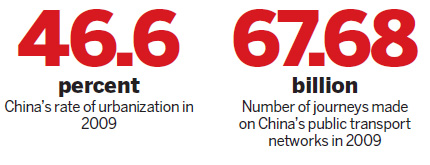
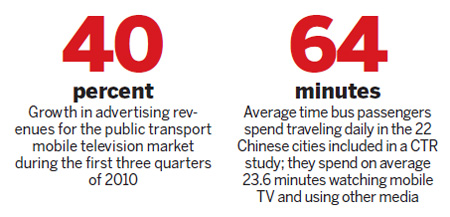
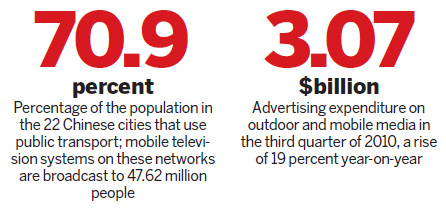
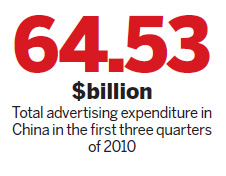
(China Daily 01/11/2011 page6)
